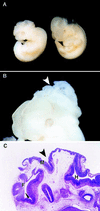Loss of function of the tuberous sclerosis 2 tumor suppressor gene results in embryonic lethality characterized by disrupted neuroepithelial growth and development
- PMID: 9861021
- PMCID: PMC28095
- DOI: 10.1073/pnas.95.26.15629
Loss of function of the tuberous sclerosis 2 tumor suppressor gene results in embryonic lethality characterized by disrupted neuroepithelial growth and development
Abstract
Germline defects in the tuberous sclerosis 2 (TSC2) tumor suppressor gene predispose humans and rats to benign and malignant lesions in a variety of tissues. The brain is among the most profoundly affected organs in tuberous sclerosis (TSC) patients and is the site of development of the cortical tubers for which the hereditary syndrome is named. A spontaneous germline inactivation of the Tsc2 locus has been described in an animal model, the Eker rat. We report that the homozygous state of this mutation (Tsc2(Ek/Ek)) was lethal in mid-gestation (the equivalent of mouse E9.5-E13.5), when Tsc2 mRNA was highly expressed in embryonic neuroepithelium. During this period homozygous mutant Eker embryos lacking functional Tsc2 gene product, tuberin, displayed dysraphia and papillary overgrowth of the neuroepithelium, indicating that loss of tuberin disrupted the normal development of this tissue. Interestingly, there was significant intraspecies variability in the penetrance of cranial abnormalities in mutant embryos: the Long-Evans strain Tsc2(Ek/Ek) embryos displayed these defects whereas the Fisher 344 homozygous mutant embryos had normal-appearing neuroepithelium. Taken together, our data indicate that the Tsc2 gene participates in normal brain development and suggest the inactivation of this gene may have similar functional consequences in both mature and embryonic brain.
Figures




References
Publication types
MeSH terms
Substances
Grants and funding
LinkOut - more resources
Full Text Sources
Medical
Molecular Biology Databases
Research Materials

